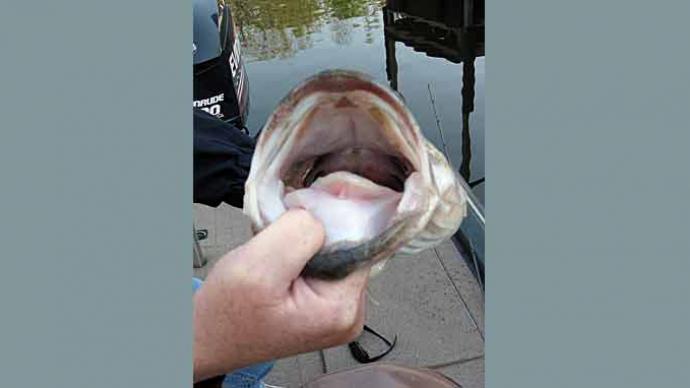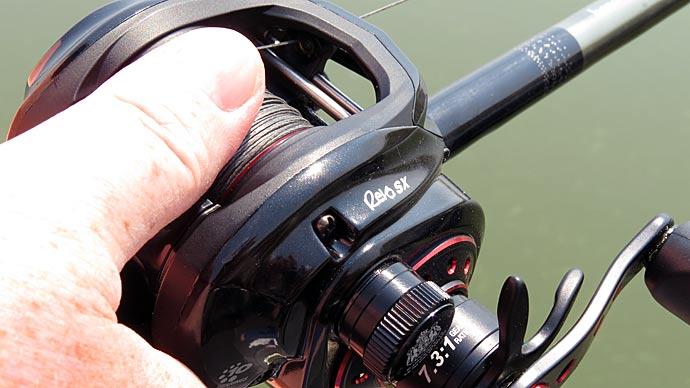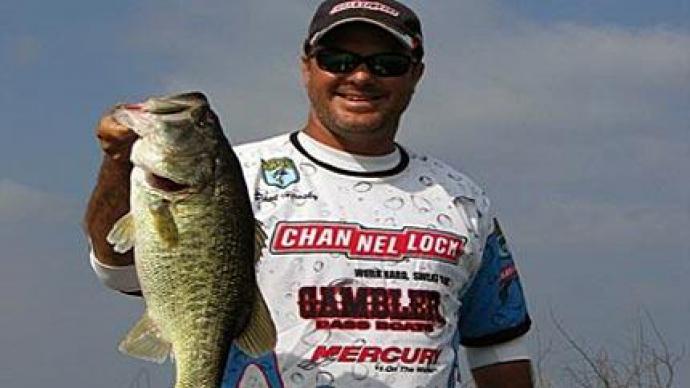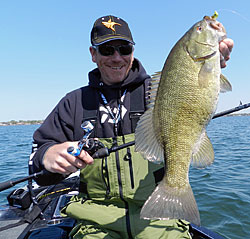
Anglers who dedicate their efforts to pursuing smallmouth bass are always looking to build a better mousetrap. From flake colors in tubes to custom-painted crankbait and topwater baits, nothing is left to chance. Yet, smallmouth are wired for speed and can spot a fake a mile away. Therein lies the beauty of the soft-plastic swimbait. Bassmaster Elite Pro Fred Roumbanis, smallmouth ace Joe Balog, and Canadian multi-species guide Frank DiMarcantonio have all found success with the technique and shared their thoughts.
Why Swimbaits Work
While spinnerbaits and rattle baits each have their place, smallmouths undoubtedly have seen their fair share of these lures. For Roumbanis, using a swimbait is an easy decision. The lure is simple to fish – cast and reel. Yet, swimbaits look entirely natural to the fish. DiMarcantonio attributes his success with the swimbait as an evolution of sorts as he’s been swimming grubs for smallies since he was a kid. Going with a larger profile is a testament to how swimbaits have evolved. Balog believes that fishing pressure is the most significant culprit for smallmouth, having resorted to attacking swimbaits. Sure, smallmouth are tired of seeing the same old lures and presentations. However, the fish are also pursued by a more intelligent angler with better tackle, boats, and electronics. Balog uses Lakemaster mapping to dial in areas he’ll dissect with a swimbait.
Where and How to Look
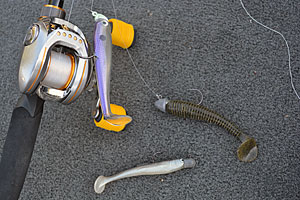
Swimbaits are not a go-to bait all the time, but any time the water is clear and hovering in the low to mid- 60’s, you best have one rigged. If you have a few variables working in your favor, the odds of success are much greater. All three anglers favor slick, calm conditions.
Roumbanis especially like to use specific rocks as part of his program. “I key in on light spots or dark spots. Light spots might indicate a gravel bottom, roadbed, shell bed, and dark spots, which indicate those dark boulder-like rocks. The dark ones are best, anywhere from a foot to 10 feet deep, depending on the clarity of the water. Once you start making some casts, you can key in on what they do. On St. Clair, when I get around dark rocks, I know I can catch them on a swimbait,” Roumbanis said.
To find those dark spots, Roumbanis uses a Garmin 1040xs and utilizes its unique mapping with the Lake VU Ultra HD. “You can map hard bottoms where smallies roam. White areas indicate hard bottom areas. Searching is just so much easier. Also, seeing your target (fish) ahead of you is a major player using the Pan Optixs. I know exactly where the fish are, their depth, and the depth of my lure all at once. Interception of the fish has never been this easy,”
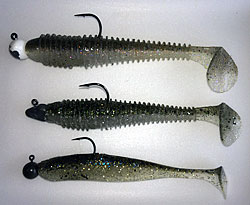
DiMarcantonio uses his Lowrance Gen 3 Touch units to zero in on points, humps, and boulder flats mixed with sand. “If you have a transition zone way-pointed that is soft to hard bottom, you can fish a swimbait along this area to get bites,” he said. “I do many different things with swimbaits. It seems it’s always windy on Erie, so we use that to our advantage by drifting swimbaits on or near the bottom at speeds from .4 to 1 mph. Adjust the head weight to find the bottom.”
Areas that include scattered tall grass are key. Balog will use his Humminbird Onix 10 to search for cabbage located in and around sandy areas. “These spots can be tough to find and don’t show up on maps, as there’s often little or no depth change. Side Imaging helps me find these areas without having to fish endlessly. I’ve spent hundreds of hours graphing to find these summertime sweet spots,” Balog said. “In the case of fishing structure on Erie, I mainly target humps and breaks because the fish key on bottom transitions where rock meets the sand. I will contact the bottom of Erie and other rocky lakes because at times. I think the bass think the swimbait is a goby.”
The Right Approach at the Right Time
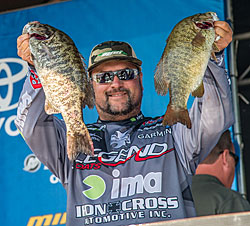
Every angler approaches each situation differently. A guide like DiMarcantonio puts his clients' needs first. He prefers fishing swimbaits on spinning tackle for the sole purpose of avoiding backlashes and facilitating longer casts. He’s found the 7’7 G Loomis SMR-913-SP, which boasts a moderate action to benefit when hooking smallmouth and landing them. Paired with a 3000 series Shimano Stradic spooled with 20 lb. Power Pro braid and a 6-foot leader of 10 lb. mono leader work great for smallmouth on Lake Erie. As the best swimbait bite goes down when the water is ultra-clear and calm, fish can spot a boat or an angler from a mile away. Stealth is paramount. Long casts are essential for covering water.
Wind and waves impact the fall rate of each swimbait, and the mood of the fish dictates the retrieve. “Watch your line, and when it goes slack, it’s on the bottom. I will either reel them right up through the column or let them touch down, reel them a bit, kill them, and swim back down to find the bottom. I do this to the boat. Let the fish tell you what they want. It never seems the same every trip. You have to experiment,” DiMarcantonio said.
His favorite swimbait is no longer a secret bait of the pros. The cat is out of the bag. Keitech’s Fat Swinging Impact in 2.8, 3.8, 4.3, 4.8, and 5.8 sizes all have their place in his rotation. “They are making it easy for fisherman to match the hatch,” DiMarcantonio said. “I find that the bigger sizes, 4.3 and 4.8, seem to work better for me on Erie in the spring and fall. I use smaller sizes during the summer. The new small 3.3 should be great during the shallow post-spawn bite when I normally swim a grub.”
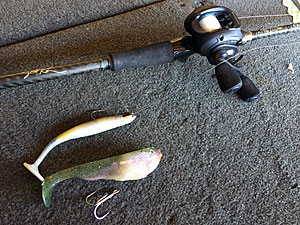
Make sure you use a head with a hook the right size for the bait. DiMarcantonio uses a football head or round ball head for most of his swimbait fishing with a 3/8oz roundhead sporting a 3/0 hook is his mainstay. “I carry a vast array of head sizes with different hooks to match the lengths of the baits. Try to get heads with double keepers,” DiMarcantonio said.
For Roumbanis, his use of a swimbait is all about maximizing efficiency as time is money for the Bassmaster Elite pro, starting with his set-up. That efficiency starts with a 7:3:1 Ardent Elite reel spooled with 20-40lb Ardent Gliss and 17-20lb fluorocarbon leader that he’ll use to launch Optimum Opti-Shad on a 7’5” iRod Genesis 2 Magic Stick.
“It has the perfect tip, lets it load up, and has plenty of backbone. Once you get the bite, the rod tip will load up. You want to keep reeling and grind back with it but constantly reel the whole time. You give smallmouth any slack, and they’ll swim toward you,” Roumbanis said. Slack is the common evil of all smallmouth fishing, as they’ll use it to their advantage to throw the hook.
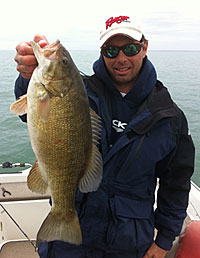
Roumbanis admits it sounds a little crazy, but he likes to use a ¾ oz Gamakatsu swimbait head with a sturdy 3/0 hook paired with a 6” Opti Shad and burn it as fast as he can reel it. Glue isn't necessary with a unique screw lock on the hook shank.
He’ll play around with retrieve speeds and varying head weights to cover the water column and cater to the fish's mood. He’ll scale back to a 1/8 oz or ¼ oz jig head if he finds fish are hesitant to bite. “You are keeping it in the same water column, just slowing down the retrieve,” Roumbanis commented. “Unless I’m working the bottom with it, which is different, I’m keying on central flats or weedlines or somewhere where they’re roaming.
When he does need to crawl bottom with a swimbait, especially in a river fishery, he’ll opt for the Optimum Top of the Line swimbait, which has a hook coming out of the top of the bait, thereby reducing snags. Using the 4-inch model, he’ll slowly crawl it along the bottom but will gauge the fish's mood.
He prefers to throw the 5” Optimum Baby Line Through rigged with a bronze 1/0 Gamakatsu EWG hook during spring and into the early post-spawn.
Balog has a few setups based on where his fish are and what they’re chewing on. If he’s trying to imitate little shiner minnows, he’ll opt for the Castaic Jerky J swimbait on a Provider Tackle mushroom head. Due to their lightweight, he prefers a Daiwa Tatula 7’M spinning rod, Daiwa Ballistic EX spinning reel, Sufix 832 braid (4/10) with an 8lb fluorocarbon leader. He prefers the lighter baits when fishing shallow in the earlier part of the season.
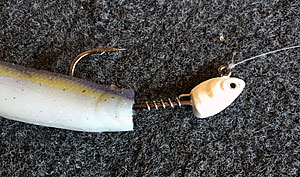
If fish are a little deeper, he’ll often let the bait fall to the bottom before swimming it in, but it’s still coming in several feet off the bottom once the retrieve starts. “I sometimes count them to suspended fish as well. I always pitch my bait out and count to see how long it takes to reach the bottom before fishing, so I know the sink rate. It’s usually 2-3 feet per second with those big baits. Sometimes, I will count them to fish I see on the graph,” Balog said.
Once water temps reach 60 degrees, he’s confident in using larger baits in deeper water to coax monster smallmouth into biting A larger hollow-bodied swimbait like the 4” and 5” BassTrix swimbaits are right in his wheelhouse rigged on a Kalin’s Ultimate Saltwater Bullet Jig, VMC BJ Boxer Jig, or J Will jig head. All have sturdy hooks and weigh ½ to ¾ oz. He opts for a Daiwa 7’6” Tatula Heavy action bait cast rod, Tatula Reel with Reel Grips spooled with 12lb to drive the hooks home. Sufix fluorocarbon.
While he is a big fan of the swimbait, Balog cautions anglers that there is no magic lure. Sometimes others will work better. To ensure you have a fair shot at success, always rig your baits straight and try to store them the same way.
Tricks of the Trade
As a guide, DiMarcantonio goes through a load of plastic swimbaits, but that’s not to say he doesn’t try to be frugal. “Here is a tip, though, when you go to mend them, I use a very sharp pair of scissors to cut the baits in half to expose the tear better. Then I mend them back together. I can repair the complete tear instead of a small portion,” DiMarcantonio said. By using Mend-It, he’s used some baits four times over.
As well, he’s an advocate of super long casts for a couple of reasons. Firstly, he wants to get his bait away from the boat to eliminate being spotted and feels much more comfortable setting the hook on fish at a distance. When he sees fish take the bait near the boat, he admits breaking them off often. The darker the sky, the brighter the bait he’ll sometimes throw, meaning he’ll use a chartreuse Spike-It pen and draw a good line down the side of his bait, whereas Balog will sometimes dye the tails and glue the heads to his baits.


